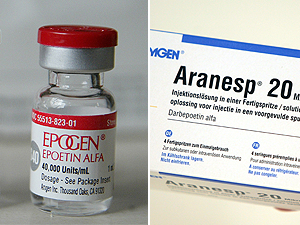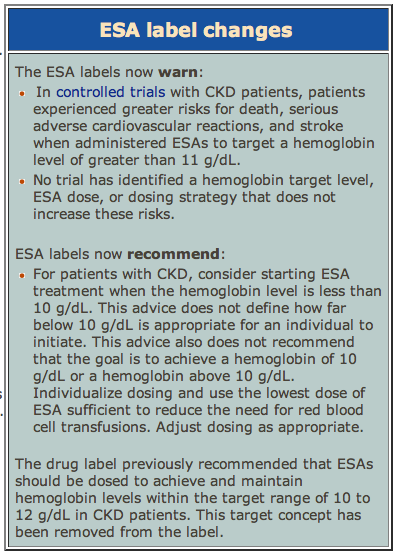
FDA表示,根據大型隨機分派研究結果,使用ESA可能增加心血管疾病風險,他們的建議是:
- 尚未接受透析的CKD患者: 僅當血紅素低於10 g/dl時才考慮開始使用ESA,如果治療後血紅素超過10 g/dl,應該考慮減少或暫停使用ESA (很硬!)
- 已經接受透析的CKD患者: 當血紅素低於10 g/dl時開始使用ESA,如果治療後血紅素超過11 g/dl,應該考慮減少或暫停使用ESA
在FDA的聲明中表示,仿單中移除了之前治療目標 (target) 的概念 (因為會讓人聯想這樣才會有效),而改採治療建議
The US Food and Drug Administration (FDA) today urged more conservative dosing guidelines for erythropoiesis-stimulating agents (ESAs) when used to treat anemia in patients with chronic kidney disease (CKD).
The recommendations are in response to clinical trials showing an increased risk for cardiovascular events, such as heart attack, stroke, thrombosis, and death, when ESAs are dosed to achieve a normal or nearly normal blood hemoglobin level, Robert C. Kane, MD, acting deputy director for safety, Division of Hematology Products, Center for Drug Evaluation and Research, said during a telephone news conference today.
The new guidelines are being added to the boxed warning and other sections of the package insert. In addition, ESAs have not been shown to improve quality of life, fatigue, or patient well-being, the FDA said in a news release.
ESAs are synthetic versions of a human protein known as erythropoietin, which stimulates primitive cells in the bone marrow to produce red blood cells and decreases the need for blood transfusion, according to the FDA.
ESAs are approved to treat some forms of anemia resulting from CKD, chemotherapy, and certain other conditions. Drugs in the ESA class are epoetin alfa, marketed as Epogen and Procrit, and darbepoetin alfa, marketed as Aranesp.
More than 20 million people aged 20 years or older in the United States have CKD, according to the Centers for Disease Control and Prevention.
"Health care practitioners should carefully consider when to begin treatment with an ESA and actively monitor dosing in patients with [CKD], keeping in mind the increased risk for serious cardiovascular events, and should talk to their patients about these potential risks," John Jenkins, MD, director of the Office of New Drugs, said in the release. "The goal is to individualize therapy and use the lowest ESA dose possible to reduce the need for red blood cell transfusions."
Product labels for ESAs have recommended dosing to achieve and maintain hemoglobin levels within the range of 10 to 12 g/dL in patients with CKD. The new package insert removes this previous concept of a "target hemoglobin range."
The revised package insert for ESA products now recommends that physicians and their patients with CKD should weigh the possible benefits of using ESAs to decrease the need for red blood cell transfusions against the increased risks for serious adverse cardiovascular events.
"Serious risks have been demonstrated when the hemoglobin level is higher than 11 [g/dL]," said Dr. Kane. "The intention of the labeling change is to encourage flexibility in individual dosing for each patient's needs. Evidence shows some reduction in the amount of transfusions with ESAs, but they do not appear to prevent it. Each physician, after observing his patient over a period of time, has to individualize that decision."
For patients with anemia of CKD who are not on dialysis, the FDA recommends that physicians consider starting ESA treatment only when the hemoglobin level is less than 10 g/dL and when certain other considerations apply. If the hemoglobin level exceeds 10 g/dL, physicians should reduce or interrupt the dose of ESA.
For patients who are on dialysis, the FDA recommends that physicians initiate ESA treatment when the hemoglobin level is less than 10 g/dL, and reduce or interrupt the dose if the hemoglobin level approaches or exceeds 11 g/dL.
The new recommendations are based on data from clinical trials including TREAT (Trial to Reduce Cardiovascular Events with Aranesp Therapy), which showed that using ESAs to target a hemoglobin level of greater than 11 g/dL increased the risk for serious adverse cardiovascular events, such as heart attack and stroke, and provided no additional benefit to patients.
No clinical trial to date has identified a hemoglobin target level, ESA dose, or dosing strategy that does not increase these risks, FDA said.
The FDA will continue to evaluate the safety of ESAs and is requiring the manufacturer, Amgen Inc, to conduct additional trials.
The FDA is also approving modifications to the existing risk evaluation and mitigation strategy for ESAs.
Adverse effects related to ESAs should be reported to MedWatch, the FDA's safety information and adverse event reporting program, by telephone at 1-800-FDA-1088, by fax at 1-800-FDA-0178, online athttps://www.accessdata.fda.gov/scripts/medwatch/medwatch-online.htm, or by mail to MedWatch, FDA, 5600 Fishers Lane, Rockville, Maryland 20852-9787.
FDA Drug Safety Communication: Modified dosing recommendations to improve the safe use of Erythropoiesis-Stimulating Agents (ESAs) in chronic kidney disease
[6-24-2011] The U.S. Food and Drug Administration (FDA) is informing healthcare professionals of modified recommendations for more conservative dosing of Erythropoiesis-Stimulating Agents (ESAs) in patients with chronic kidney disease (CKD) to improve the safe use of these drugs. FDA has made these recommendations because of data showing increased risks of cardiovascular events with ESAs in this patient population. The manufacturer has revised the Boxed Warning, Warnings and Precautions, and Dosage and Administration sections of the labels for the ESAs to include this new information.
More than 20 million people aged 20 years or older in the United States have CKD.1 Patients with CKD lose the ability to make red blood cells and become anemic. The ESAs treat certain types of anemia by stimulating the bone marrow to produce red blood cells and by decreasing the need for blood transfusions. Drugs in the ESA class are epoetin alfa (marketed as Epogen and Procrit) and darbepoetin alfa (marketed as Aranesp).
Healthcare professionals should weigh the possible benefits of using ESAs to decrease the need for red blood cell transfusions in CKD patients against the increased risks for serious cardiovascular events, and should inform their patients of the current understanding of potential risks and benefits. Therapy should be individualized to the patient and the lowest possible ESA dose given to reduce the need for transfusions.
Treatment with ESAs in CKD has also been discussed at FDA Advisory Committee meetings in September 2007 and October 2010.
FDA is continuing to evaluate the safety of ESAs and is requiring the manufacturer to conduct additional trials. FDA will update the public when more information is available.
Additional Information for Patients with CKD
- The use of ESAs can increase the risk for stroke, heart attack, heart failure, blood clots, and death.
- The ESA Medication Guide (Epogen/Procrit orAranesp) contains information on the benefits and risks of using these drugs.
- Patients should have blood tests while using ESAs. The test results may help guide treatment and lower the risks of using these drugs. A healthcare professional will indicate how often to have blood tests.
- Questions or concerns about ESAs should be discussed with a healthcare professional.
- Side effects experienced with ESAs should be reported to the FDA MedWatch program, using the information at the bottom of the page in the "Contact Us" box.
Additional Information for Healthcare Professionals who Treat Patients with CKD
- Using ESAs to target a hemoglobin level of greater than 11 g/dL increases the risk of serious adverse cardiovascular events and has not been shown to provide additional patient benefit.
- No clinical trial to date has identified a hemoglobin target level, ESA dose, or dosing strategy that does not increase these risks.
- The ESA Medication Guide (Epogen/Procrit or Aranesp) should be provided to each patient or their representative when an ESA is dispensed.
- The lowest ESA dose sufficient to reduce the need for red blood cell transfusions should be used.
- For patients with CKD not on dialysis:
o Consider initiating ESA treatment only when the hemoglobin level is less than 10 g/dL and the following considerations apply:
– The rate of hemoglobin decline indicates the likelihood of requiring a red blood cell transfusion; and
– Reducing the risk of alloimmunization and/or other red blood cell transfusion-related risks is a goal.
o If the hemoglobin level exceeds 10 g/dL, reduce or interrupt the dose of ESA and use the lowest dose of ESA sufficient to reduce the need for red blood cell transfusions.
- For patients with CKD on dialysis:
o Initiate ESA treatment when the hemoglobin level is less than 10 g/dL.
o If the hemoglobin level approaches or exceeds 11 g/dL, reduce or interrupt the dose of ESA.
- When initiating or adjusting therapy, monitor hemoglobin levels at least weekly until stable, then monitor at least monthly.
- For patients who do not respond adequately over a 12-week escalation period, increasing the ESA dose further is unlikely to improve response and may increase risks.
- Adverse events involving ESAs should be reported to the FDA MedWatch program, using the information at the bottom of the page in the "Contact Us" box.






 留言列表
留言列表
 線上藥物查詢
線上藥物查詢 